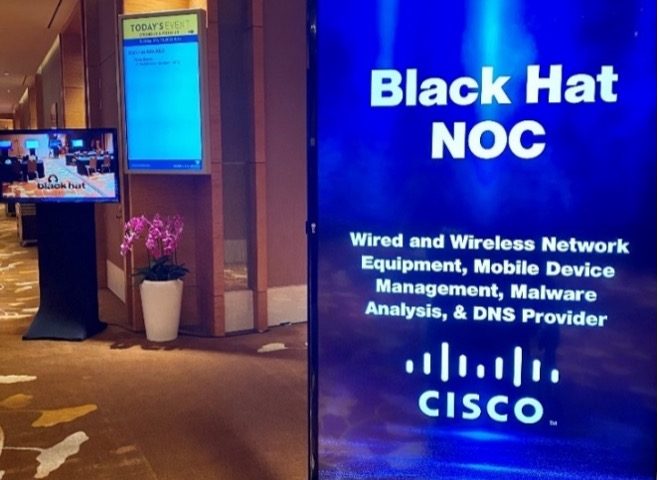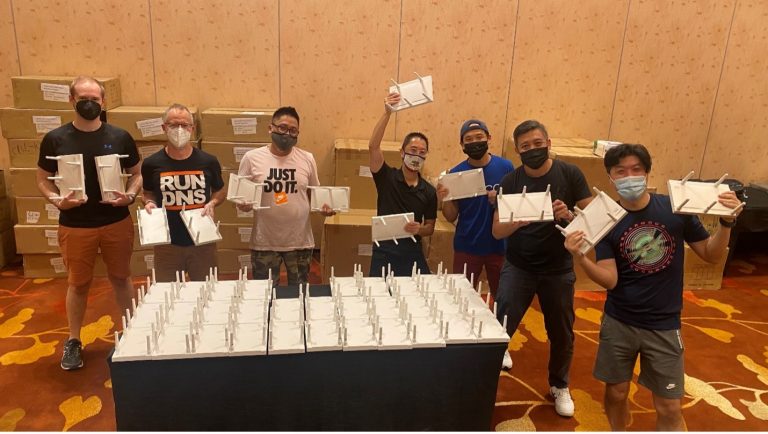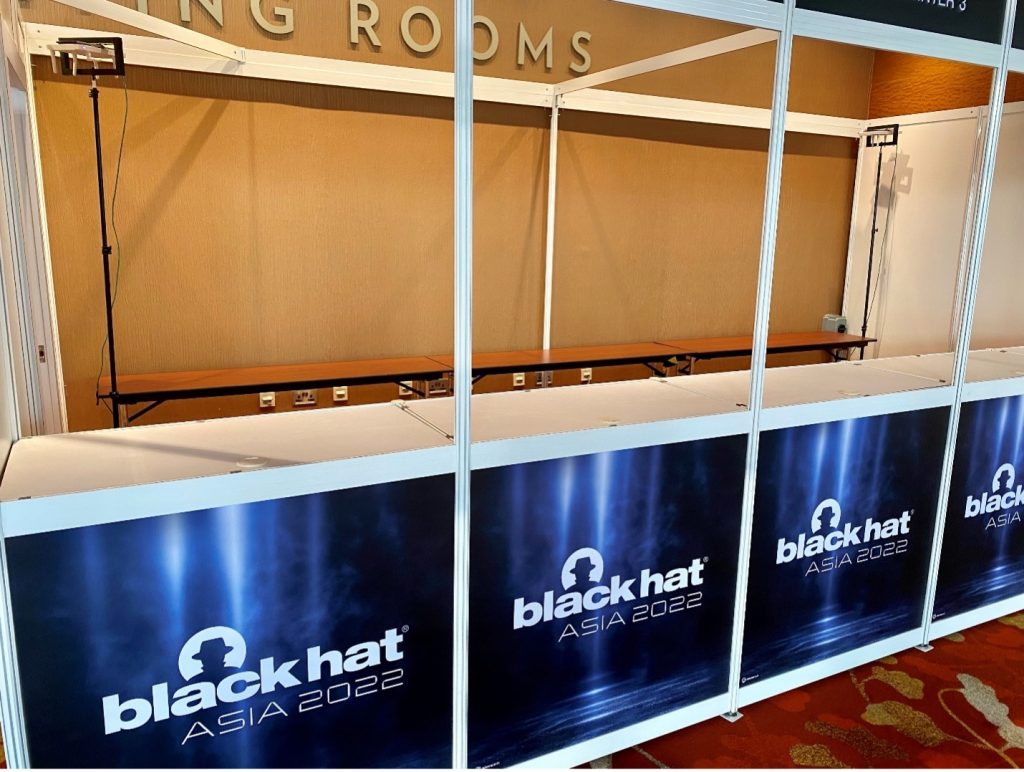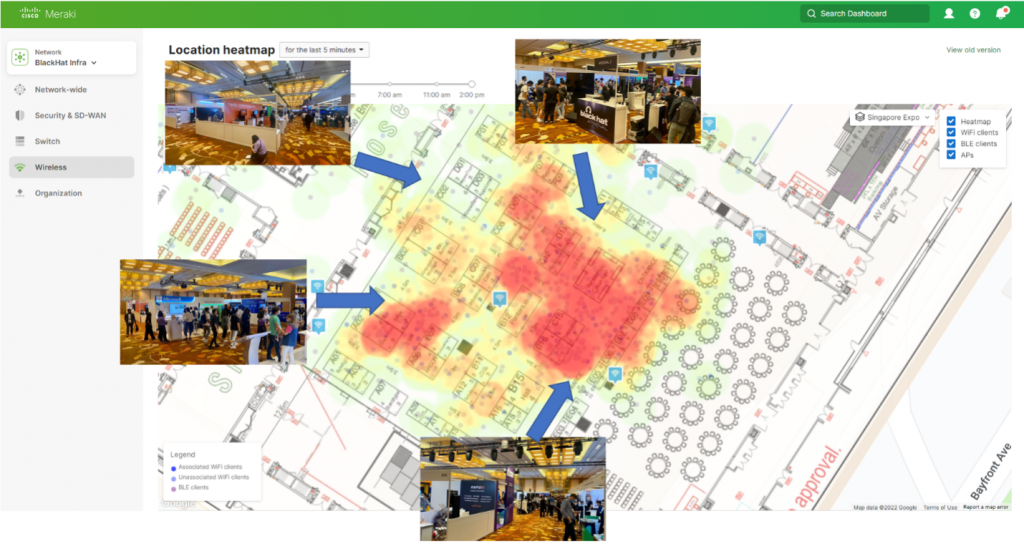
Get More from Your Cybersecurity Spend When Inflation Rates Climb
May 26, 2022
Black Hat Asia 2022 Continued: Cisco Secure Integrations
May 27, 2022Black Hat Asia 2022: Building the Network

In part one of this issue of our Black Hat Asia NOC blog, you will find:
- From attendee to press to volunteer – coming back to Black Hat as NOC volunteer by Humphrey Cheung
- Meraki MR, MS, MX and Systems Manager by Paul Fidler
- Meraki Scanning API Receiver by Christian Clasen
Cisco Meraki was asked by Black Hat Events to be the Official Wired and Wireless Network Equipment, for Black Hat Asia 2022, in Singapore, 10-13 May 2022; in addition to providing the Mobile Device Management (since Black Hat USA 2021), Malware Analysis (since Black Hat USA 2016), & DNS (since Black Hat USA 2017) for the Network Operations Center. We were proud to collaborate with NOC partners Gigamon, IronNet, MyRepublic, NetWitness and Palo Alto Networks.

To accomplish this undertaking in a few weeks’ time, after the conference had a green light with the new COVID protocols, Cisco Meraki and Cisco Secure leadership gave their full support to send the necessary hardware, software licenses and staff to Singapore. Thirteen Cisco engineers deployed to the Marina Bay Sands Convention Center, from Singapore, Australia, United States and United Kingdom; with two additional remote Cisco engineers from the United States.
From attendee to press to volunteer – coming back to Black Hat as NOC volunteer by Humphrey Cheung
Loops in the networking world are usually considered a bad thing. Spanning tree loops and routing loops happen in an instant and can ruin your whole day, but over the 2nd week in May, I made a different kind of loop. Twenty years ago, I first attended the Black Hat and Defcon conventions – yay Caesars Palace and Alexis Park – a wide-eyed tech newbie who barely knew what WEP hacking, Driftnet image stealing and session hijacking meant. The community was amazing and the friendships and knowledge I gained, springboarded my IT career.
In 2005, I was lucky enough to become a Senior Editor at Tom’s Hardware Guide and attended Black Hat as accredited press from 2005 to 2008. From writing about the latest hardware zero-days to learning how to steal cookies from the master himself, Robert Graham, I can say, without any doubt, Black Hat and Defcon were my favorite events of the year.
Since 2016, I have been a Technical Solutions Architect at Cisco Meraki and have worked on insanely large Meraki installations – some with twenty thousand branches and more than a hundred thousand access points, so setting up the Black Hat network should be a piece of cake right? Heck no, this is unlike any network you’ve experienced!
As an attendee and press, I took the Black Hat network for granted. To take a phrase that we often hear about Cisco Meraki equipment, “it just works”. Back then, while I did see access points and switches around the show, I never really dived into how everything was set up.

A serious challenge was to secure the needed hardware and ship it in time for the conference, given the global supply chain issues. Special recognition to Jeffry Handal for locating the hardware and obtaining the approvals to donate to Black Hat Events. For Black Hat Asia, Cisco Meraki shipped:
- 45 Meraki MR wireless access points
- Seven Meraki MS cloud-managed stackable access switches
- Two Meraki MX routers/security appliances
- Cisco Meraki Systems Manager mobile device management and security
Let’s start with availability. iPads and iPhones are scanning QR codes to register attendees. Badge printers need access to the registration system. Training rooms all have their separate wireless networks – after all, Black Hat attendees get a baptism by fire on network defense and attack. To top it all off, hundreds of attendees gulped down terabytes of data through the main conference wireless network.
All this connectivity was provided by Cisco Meraki access points, switches, security appliances, along with integrations into SecureX, Umbrella and other products. We fielded a literal army of engineers to stand up the network in less than two days… just in time for the training sessions on May 10 to 13th and throughout the Black Hat Briefings and Business Hall on May 12 and 13.

Let’s talk security and visibility. For a few days, the Black Hat network is probably one of the most hostile in the world. Attendees learn new exploits, download new tools and are encouraged to test them out. Being able to drill down on attendee connection details and traffic was instrumental on ensuring attendees didn’t get too crazy.
On the wireless front, we made extensive use of our Radio Profiles to reduce interference by tuning power and channel settings. We enabled band steering to get more clients on the 5GHz bands versus 2.4GHz and watched the Location Heatmap like a hawk looking for hotspots and dead areas. Handling the barrage of wireless change requests – enable or disabling this SSID, moving VLANs (Virtual Local Area Networks), enabling tunneling or NAT mode, – was a snap with the Meraki Dashboard.
Shutting Down a Network Scanner
While the Cisco Meraki Dashboard is extremely powerful, we happily supported exporting of logs and integration in major event collectors, such as the NetWitness SIEM and even the Palo Alto firewall. On Thursday morning, the NOC team found a potentially malicious Macbook Pro performing vulnerability scans against the Black Hat management network. It is a balance, as we must allow trainings and demos connect to malicious websites, download malware and execute. However, there is a Code of Conduct to which all attendees are expected to follow and is posted at Registration with a QR code.
The Cisco Meraki network was exporting syslog and other information to the Palo Alto firewall, and after correlating the data between the Palo Alto Dashboard and Cisco Meraki client details page, we tracked down the laptop to the Business Hall.

We briefed the NOC management, who confirmed the scanning was violation of the Code of Conduct, and the device was blocked in the Meraki Dashboard, with the instruction to come to the NOC.

The device name and location made it very easy to determine to whom it belonged in the conference attendees.

A delegation from the NOC went to the Business Hall, politely waited for the demo to finish at the booth and had a thoughtful conversation with the person about scanning the network. 
Coming back to Black Hat as a NOC volunteer was an amazing experience. While it made for long days with little sleep, I really can’t think of a better way to give back to the conference that helped jumpstart my professional career.
Meraki MR, MS, MX and Systems Manager by Paul Fidler
With the invitation extended to Cisco Meraki to provide network access, both from a wired and wireless perspective, there was an opportunity to show the value of the Meraki platform integration capabilities of Access Points (AP), switches, security appliances and mobile device management.

The first amongst this was the use of the Meraki API. We were able to import the list of MAC addresses of the Meraki MRs, to ensure that the APs were named appropriately and tagged, using a single source of truth document shared with the NOC management and partners, with the ability to update en masse at any time.
Floor Plan and Location Heatmap
On the first day of NOC setup, the Cisco team walked around the venue to discuss AP placements with the staff of the Marina Bay Sands. Whilst we had a simple Powerpoint showing approximate AP placements for the conference, it was noted that the venue team had an incredibly detailed floor plan of the venue. This was acquired in PDF and uploaded into the Meraki Dashboard; and with a little fine tuning, aligned perfectly with the Google Map.

Meraki APs were then placed physically in the venue meeting and training rooms, and very roughly on the floor plan. One of the team members then used a printout of the floor plan to mark accurately the placement of the APs. Having the APs named, as mentioned above, made this an easy task (walking around the venue notwithstanding!). This enabled accurate heatmap capability.
The Location Heatmap was a new capability for Black Hat NOC, and the client data visualized in NOC continued to be of great interest to the Black Hat management team, such as which training, briefing and sponsor booths drew the most interest.

SSID Availability
The ability to use SSID Availability was incredibly useful. It allowed ALL of the access points to be placed within a single Meraki Network. Not only that, because of the training events happening during the week, as well as TWO dedicated SSIDs for the Registration and lead tracking iOS devices (more of which later), one for initial provisioning (which was later turned off), and one for certificated based authentication, for a very secure connection.
Network Visibility
We were able to monitor the number of connected clients, network usage, the persons passing by the network and location analytics, throughout the conference days. We provided visibility access to the Black Hat NOC management and the technology partners (along with full API access), so they could integrate with the network platform.



Alerts
Meraki alerts are exactly that: the ability to be alerted to something that happens in the Dashboard. Default behavior is to be emailed when something happens. Obviously, emails got lost in the noise, so a web hook was created in SecureX orchestration to be able to consume Meraki alerts and send it to Slack (the messaging platform within the Black Hat NOC), using the native template in the Meraki Dashboard. The first alert to be created was to be alerted if an AP went down. We were to be alerted after five minutes of an AP going down, which is the smallest amount of time available before being alerted.

The bot was ready; however, the APs stayed up the entire time!
Meraki Systems Manager
Applying the lessons learned at Black Hat Europe 2021, for the initial configuration of the conference iOS devices, we set up the Registration iPads and lead retrieval iPhones with Umbrella, Secure Endpoint and WiFi config. Devices were, as in London, initially configured using Apple Configurator, to both supervise and enroll the devices into a new Meraki Systems Manager instance in the Dashboard.

However, Black Hat Asia 2022 offered us a unique opportunity to show off some of the more integrated functionality.
System Apps were hidden and various restrictions (disallow joining of unknown networks, disallow tethering to computers, etc.) were applied, as well as a standard WPA2 SSID for the devices that the device vendor had set up (we gave them the name of the SSID and Password).
We also stood up a new SSID and turned-on Sentry, which allows you to provision managed devices with, not only the SSID information, but also a dynamically generated certificate. The certificate authority and radius server needed to do this 802.1x is included in the Meraki Dashboard automatically! When the device attempts to authenticate to the network, if it doesn’t have the certificate, it doesn’t get access. This SSID, using SSID availability, was only available to the access points in the Registration area.
Using the Sentry allowed us to easily identify devices in the client list.

One of the alerts generated with SysLog by Meraki, and then viewable and correlated in the NetWitness SIEM, was a ‘De Auth’ event that came from an access point. Whilst we had the IP address of the device, making it easy to find, because the event was a de auth, meaning 802.1x, it narrowed down the devices to JUST the iPads and iPhones used for registration (as all other access points were using WPA2). This was further enhanced by seeing the certificate name used in the de-auth:

Along with the certificate name was the name of the AP: R**
Device Location
One of the inherent problems with iOS device location is when devices are used indoors, as GPS signals just aren’t strong enough to penetrate modern buildings. However, because the accurate location of the Meraki access points was placed on the floor plan in the Dashboard, and because the Meraki Systems Manager iOS devices were in the same Dashboard organization as the access points, we got to see a much more accurate map of devices compared to Black Hat Europe 2021 in London.

When the conference Registration closed on the last day and the Business Hall Sponsors all returned their iPhones, we were able to remotely wipe all of the devices, removing all attendee data, prior to returning to the device contractor.

Meraki Scanning API Receiver by Christian Clasen
Leveraging the ubiquity of both WiFi and Bluetooth radios in mobile devices and laptops, Cisco Meraki’s wireless access points can detect and provide location analytics to report on user foot traffic behavior. This can be useful in retail scenarios where customers desire location and movement data to better understand the trends of engagement in their physical stores.
Meraki can aggregate real-time data of detected WiFi and Bluetooth devices and triangulate their location rather precisely when the floorplan and AP placement has been diligently designed and documented. At the Black Hat Asia conference, we made sure to properly map the AP locations carefully to ensure the highest accuracy possible.
This scanning data is available for clients whether they are associated with the access points or not. At the conference, we were able to get very detailed heatmaps and time-lapse animations representing the movement of attendees throughout the day. This data is valuable to conference organizers in determining the popularity of certain talks, and the attendance at things like keynote presentations and foot traffic at booths.

This was great for monitoring during the event, but the Dashboard would only provide 24-hours of scanning data, limiting what we could do when it came to long-term data analysis. Fortunately for us, Meraki offers an API service we can use to capture this treasure trove offline for further analysis. We only needed to build a receiver for it.
The Receiver Stack
The Scanning API requires that the customer stand up infrastructure to store the data, and then register with the Meraki cloud using a verification code and secret. It is composed of two endpoints:
- Validator
Returns the validator string in the response body
[GET] https://yourserver/
This endpoint is called by Meraki to validate the receiving server. It expects to receive a string that matches the validator defined in the Meraki Dashboard for the respective network.
- Receiver
Accepts an observation payload from the Meraki cloud
[POST] https://yourserver/
This endpoint is responsible for receiving the observation data provided by Meraki. The URL path should match that of the [GET] request, used for validation.
The response body will consist of an array of JSON objects containing the observations at an aggregate per network level. The JSON will be determined based on WiFi or BLE device observations as indicated in the type parameter.

What we needed was a simple technology stack that would contain (at minimum) a publicly accessible web server capable of TLS. In the end, the simplest implementation was a web server written using Python Flask, in a Docker container, deployed in AWS, connected through ngrok.
In fewer than 50 lines of Python, we could accept the inbound connection from Meraki and reply with the chosen verification code. We would then listen for the incoming POST data and dump it into a local data store for future analysis. Since this was to be a temporary solution (the duration of the four-day conference), the thought of registering a public domain and configuring TLS certificates wasn’t particularly appealing. An excellent solution for these types of API integrations is ngrok (https://ngrok.com/). And a handy Python wrapper was available for simple integration into the script (https://pyngrok.readthedocs.io/en/latest/index.html).
We wanted to easily re-use this stack next time around, so it only made sense to containerize it in Docker. This way, the whole thing could be stood up at the next conference, with one simple command. The image we ended up with would mount a local volume, so that the ingested data would remain persistent across container restarts.
Ngrok allowed us to create a secure tunnel from the container that could be connected in the cloud to a publicly resolvable domain with a trusted TLS certificate generated for us. Adding that URL to the Meraki Dashboard is all we needed to do start ingesting the massive treasure trove of location data from the Aps – nearly 1GB of JSON over 24 hours.

This “quick and dirty” solution illustrated the importance of interoperability and openness in the technology space when enabling security operations to gather and analyze the data they require to monitor and secure events like Black Hat, and their enterprise networks as well. It served us well during the conference and will certainly be used again going forward.

Check out part two of the blog, Black Hat Asia 2022 Continued: Cisco Secure Integrations, where we will discuss integrating NOC operations and making your Cisco Secure deployment more effective:
- SecureX: Bringing Threat Intelligence Together by Ian Redden
- Device type spoofing event by Jonny Noble
- Self Service with SecureX Orchestration and Slack by Matt Vander Horst
- Using SecureX sign-on to streamline access to the Cisco Stack at Black Hat by Adi Sankar
- Future Threat Vectors to Consider – Cloud App Discovery by Alejo Calaoagan
- Malware Threat Intelligence made easy and available, with Cisco Secure Malware Analytics and SecureX by Ben Greenbaum
Acknowledgements: Special thanks to the Cisco Meraki and Cisco Secure Black Hat NOC team: Aditya Sankar, Aldous Yeung, Alejo Calaoagan, Ben Greenbaum, Christian Clasen, Felix H Y Lam, George Dorsey, Humphrey Cheung, Ian Redden, Jeffrey Chua, Jeffry Handal, Jonny Noble, Matt Vander Horst, Paul Fidler and Steven Fan.
Also, to our NOC partners NetWitness (especially David Glover), Palo Alto Networks (especially James Holland), Gigamon, IronNet (especially Bill Swearington), and the entire Black Hat / Informa Tech staff (especially Grifter ‘Neil Wyler’, Bart Stump, James Pope, Steve Fink and Steve Oldenbourg).
About Black Hat
For more than 20 years, Black Hat has provided attendees with the very latest in information security research, development, and trends. These high-profile global events and trainings are driven by the needs of the security community, striving to bring together the best minds in the industry. Black Hat inspires professionals at all career levels, encouraging growth and collaboration among academia, world-class researchers, and leaders in the public and private sectors. Black Hat Briefings and Trainings are held annually in the United States, Europe and Asia. More information is available at: blackhat.com. Black Hat is brought to you by Informa Tech.
We’d love to hear what you think. Ask a Question, Comment Below, and Stay Connected with Cisco Secure on social!
Cisco Secure Social Channels

